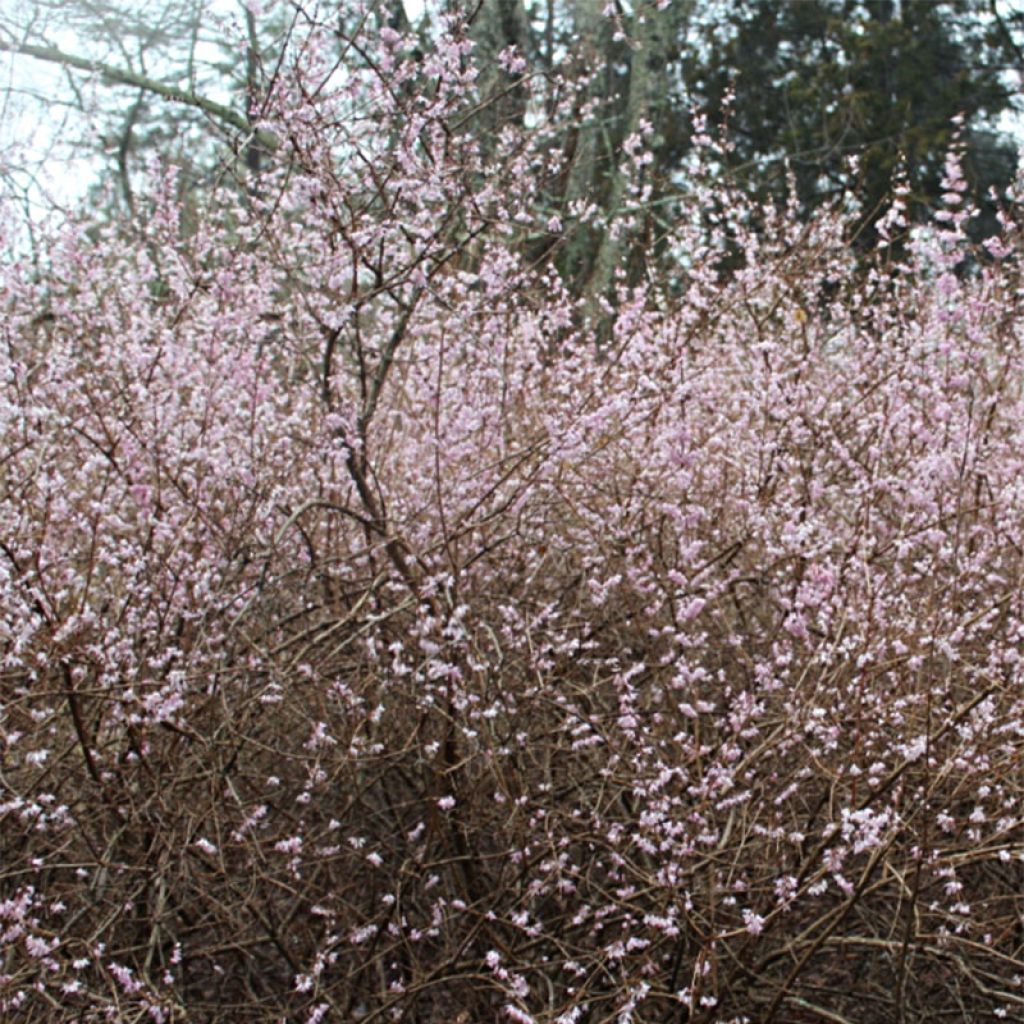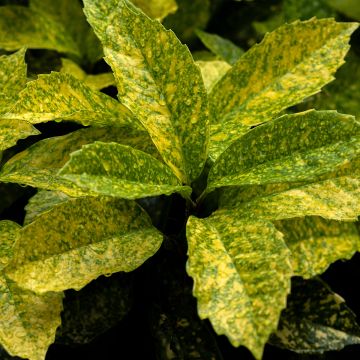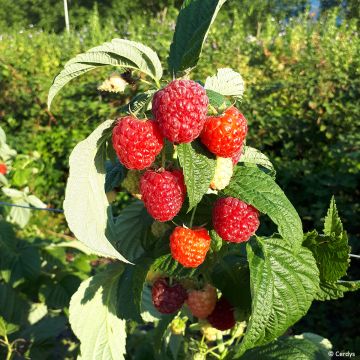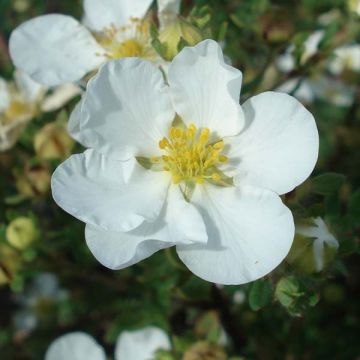

Abeliophyllum distichum Roseum


Abeliophyllum distichum Roseum


Abeliophyllum distichum Roseum
Abeliophyllum distichum Roseum
Abeliophyllum distichum Roseum
White Forsythia
Arrived safely! Now I'm waiting to see its growth.
Jo, 29/03/2022
This plant carries a 24 months recovery warranty
More information
We guarantee the quality of our plants for a full growing cycle, and will replace at our expense any plant that fails to recover under normal climatic and planting conditions.
From €5.90 for pickup delivery and €6.90 for home delivery
Express home delivery from €8.90.
Does this plant fit my garden?
Set up your Plantfit profile →
Description
The Abeliophyllum distichum Roseum, is a deciduous shrub that resembles a pink-flowered forsythia in its foliage and flowering, but is much less commonly used in our gardens despite its many qualities. Its small clusters of flowers exude a sweet scent reminiscent of almonds, a real pleasure in late winter. They bloom along the length of its brown and bare branches. It is no more difficult to cultivate than its cousin and offers superb autumn foliage as a bonus. This shrub appreciates the sun and adapts to any ordinary soil. It should be planted near the house to fully enjoy its fragrance at a time when the garden is still asleep.
The Korean Forsythia is a shrub belonging to the olive family. It is a particular form of Abeliophyllum distichum, whose flowers are pinker at blooming and retain their colouration for longer before fading to white. It is native to Eastern Asia, particularly central South Korea, where it has become very rare. The pink forsythia is a slow-growing shrub with an upright bushy habit, reaching 1.50m (5ft) to 2m (6.5ft) in all directions. It flowers at the end of winter, in February-March, on the previous year's branches and before the appearance of foliage. The small bell-shaped flowers, grouped in numerous clusters, are composed of 4 petals and emit an almond scent. Measuring 1.5cm (0.6in) in diameter, they are tender pink with a yellow-orange centre. They turn light brown at the end of flowering.
The Korean Abelia Roseum is a nectar-rich plant. Its foliage is deciduous and dark green turning reddish-purple in autumn. The leaves measure 8cm (3.1in) in length. They are arranged in two rows, hence the name distichum, from the Greek 'dis' meaning two and 'stikhos' meaning row.
Abeliophyllum distichum Roseum is very hardy and undemanding once well-established. It is best planted near the house to be admired from the inside. It blends well with a low hedge due to its modest size and natural appearance. Train it against a wall, where it will be at its best. It also fits well in the front row of a border with taller shrubs such as buddleias, lilacs, viburnums, smoke bushes, or amelanchiers. Cut a few branches in early December and place them in a vase, they will be in bloom by Christmas.
Report an error about the product description
Abeliophyllum distichum Roseum in pictures


Plant habit
Flowering
Foliage
Botanical data
Abeliophyllum
distichum
Roseum
Oleaceae
White Forsythia
East Asia
Other Abeliophyllum distichum
Planting and care
Korean Forsythia thrives in the sun or partial shade, sheltered from cold winds. You can train it against a wall, where it will be at its best. Grow in a dry to moist, well-drained soil. It is very tolerant and can thrive in both poor and rich soil. It does not like excessive moisture. In April-May, after flowering, prune all branches to ¼ of their length so that the plant produces new shoots at the base. The young bush can be quite weak, which is why it needs to be taken care of.
Planting period
Intended location
Care
-
, onOrder confirmed
Reply from on Promesse de fleurs
Hedge shrubs
Haven't found what you were looking for?
Hardiness is the lowest winter temperature a plant can endure without suffering serious damage or even dying. However, hardiness is affected by location (a sheltered area, such as a patio), protection (winter cover) and soil type (hardiness is improved by well-drained soil).

Photo Sharing Terms & Conditions
In order to encourage gardeners to interact and share their experiences, Promesse de fleurs offers various media enabling content to be uploaded onto its Site - in particular via the ‘Photo sharing’ module.
The User agrees to refrain from:
- Posting any content that is illegal, prejudicial, insulting, racist, inciteful to hatred, revisionist, contrary to public decency, that infringes on privacy or on the privacy rights of third parties, in particular the publicity rights of persons and goods, intellectual property rights, or the right to privacy.
- Submitting content on behalf of a third party;
- Impersonate the identity of a third party and/or publish any personal information about a third party;
In general, the User undertakes to refrain from any unethical behaviour.
All Content (in particular text, comments, files, images, photos, videos, creative works, etc.), which may be subject to property or intellectual property rights, image or other private rights, shall remain the property of the User, subject to the limited rights granted by the terms of the licence granted by Promesse de fleurs as stated below. Users are at liberty to publish or not to publish such Content on the Site, notably via the ‘Photo Sharing’ facility, and accept that this Content shall be made public and freely accessible, notably on the Internet.
Users further acknowledge, undertake to have ,and guarantee that they hold all necessary rights and permissions to publish such material on the Site, in particular with regard to the legislation in force pertaining to any privacy, property, intellectual property, image, or contractual rights, or rights of any other nature. By publishing such Content on the Site, Users acknowledge accepting full liability as publishers of the Content within the meaning of the law, and grant Promesse de fleurs, free of charge, an inclusive, worldwide licence for the said Content for the entire duration of its publication, including all reproduction, representation, up/downloading, displaying, performing, transmission, and storage rights.
Users also grant permission for their name to be linked to the Content and accept that this link may not always be made available.
By engaging in posting material, Users consent to their Content becoming automatically accessible on the Internet, in particular on other sites and/or blogs and/or web pages of the Promesse de fleurs site, including in particular social pages and the Promesse de fleurs catalogue.
Users may secure the removal of entrusted content free of charge by issuing a simple request via our contact form.
The flowering period indicated on our website applies to countries and regions located in USDA zone 8 (France, the United Kingdom, Ireland, the Netherlands, etc.)
It will vary according to where you live:
- In zones 9 to 10 (Italy, Spain, Greece, etc.), flowering will occur about 2 to 4 weeks earlier.
- In zones 6 to 7 (Germany, Poland, Slovenia, and lower mountainous regions), flowering will be delayed by 2 to 3 weeks.
- In zone 5 (Central Europe, Scandinavia), blooming will be delayed by 3 to 5 weeks.
In temperate climates, pruning of spring-flowering shrubs (forsythia, spireas, etc.) should be done just after flowering.
Pruning of summer-flowering shrubs (Indian Lilac, Perovskia, etc.) can be done in winter or spring.
In cold regions as well as with frost-sensitive plants, avoid pruning too early when severe frosts may still occur.
The planting period indicated on our website applies to countries and regions located in USDA zone 8 (France, United Kingdom, Ireland, Netherlands).
It will vary according to where you live:
- In Mediterranean zones (Marseille, Madrid, Milan, etc.), autumn and winter are the best planting periods.
- In continental zones (Strasbourg, Munich, Vienna, etc.), delay planting by 2 to 3 weeks in spring and bring it forward by 2 to 4 weeks in autumn.
- In mountainous regions (the Alps, Pyrenees, Carpathians, etc.), it is best to plant in late spring (May-June) or late summer (August-September).
The harvesting period indicated on our website applies to countries and regions in USDA zone 8 (France, England, Ireland, the Netherlands).
In colder areas (Scandinavia, Poland, Austria...) fruit and vegetable harvests are likely to be delayed by 3-4 weeks.
In warmer areas (Italy, Spain, Greece, etc.), harvesting will probably take place earlier, depending on weather conditions.
The sowing periods indicated on our website apply to countries and regions within USDA Zone 8 (France, UK, Ireland, Netherlands).
In colder areas (Scandinavia, Poland, Austria...), delay any outdoor sowing by 3-4 weeks, or sow under glass.
In warmer climes (Italy, Spain, Greece, etc.), bring outdoor sowing forward by a few weeks.














































